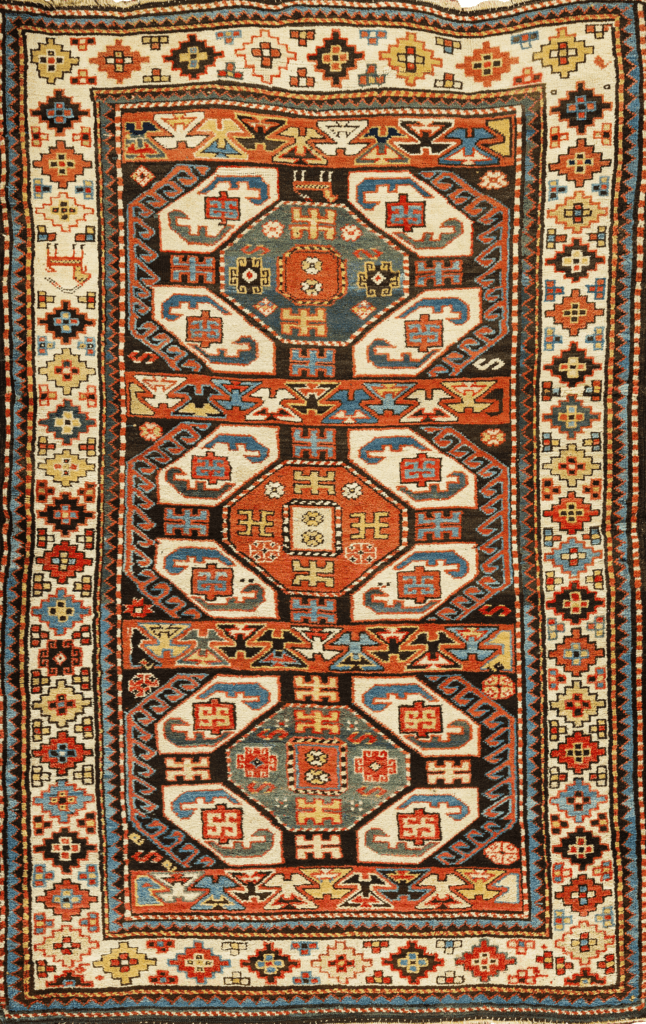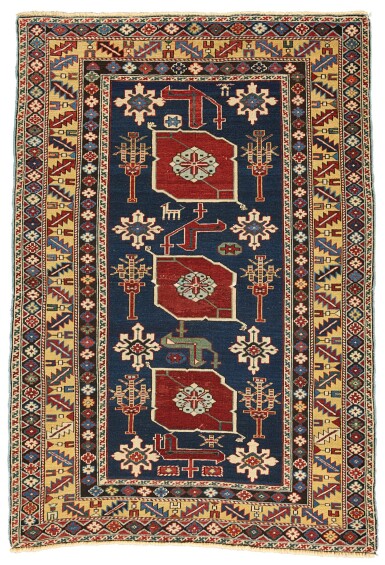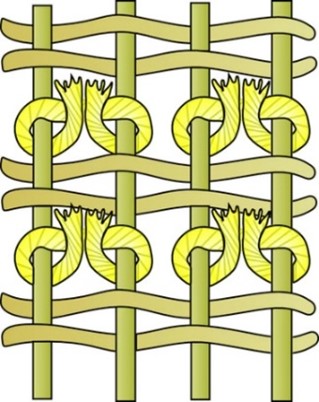The irresistible charm of ancient Caucasian rugs
It is no wonder that rugs from the numerous Caucasian groups enjoy universal popularity among today’s antique oriental rug collectors. Both the thicker pile carpets of the mountainous regions of Kazak, Karabagh and Gendje, and the finer pile carpets of Kuba, Shirvan and Dagestan, on the lower slopes of the Caspian Sea, are equally enchanting. These rugs are the last vestiges of an ancient tradition of rug making that has practically disappeared. They are living examples that tell us about the joy and deep understanding of life that their creators, the artists from the Caucasus Mountains, had.
The Caucasus region is a mosaic of ethnic groups. An important axis between the Russian steppes to the north and the Persian and Turkish empires to the south, the territory of the Caucasus is a passage from the west (Europe) to the east (Asia) and has been, since ancient times, an area of constant ambition of your neighbors. The repeated invasions that the Caucasus has suffered throughout history have left their marks and were adopted and adapted by the Caucasian peoples.

In the distant past, invading hordes of Cimmerians and Scythians from the Eurasian steppes attacked the Caucasus. Then, it was the turn of the Greeks and Romans to infiltrate through the Bosphorus. Later, Persia and Byzantium disputed control of this passage between Asia and Europe. After the 12th century, the Arabs, the Seljuks, the Turks, the Mongols of Genghis Khan and Timur attacked the Caucasian peoples. With the fall of Constantinople, the Persians and Turks resumed the attack and fought again for the Caucasus. When the Russians finally took over the Caucasus, they found the influences left by the countless invaders that were given new meanings by the Caucasians.
All this cultural confluence appears in some way in the artistic works of Caucasian carpets. It is not surprising that there are around 115 different patterns or designs among the rugs produced in this region.
What stands out most about the antique Caucasian rug is the bold use of color. Color balance is not achieved by the proximity of colors and tones, but by the contrast of strong colors. The predominant reds, blues, greens and yellows might appear to clash, but in reality, Caucasian artists created color combinations so harmonious that they have been admired and studied by Western artists for centuries.
The Caucasus is one of the world’s carpet production centers. Due to its proximity to the silk routes, its artists were influenced by many carpet-making traditions, from Egypt to China. Caucasian people, working on small, portable looms, created sophisticated rugs and transformed mythological figures into simple, stylized geometric proportions with spontaneity.
Dragon, botéh, flower, arabesque, palm leaf, bird, animal, cloud and crab designs are very common. Sometimes several of them are found in a single antique rug! In the middle of powerful geometric diamonds there can be a small horse, a bird or a gazelle. Determination and intensity go hand in hand with good humor and lightness and demonstrate the dexterity of Caucasian weavers.

Caucasian Kuba, 1875
Caucasians wove rugs for daily use, to satisfy their creativity and produce harmony in their interiors. Consequently, they did this work with a care and dedication that is almost incomprehensible to us today. The wool they used provided a superior level of resilience and shine because it was shorn from the sheep they themselves grazed in the high mountains. They then washed the wool repeatedly so that the carpet could completely absorb the vegetable dyes. For Caucasian weavers, the carpet did not become a work of art only when they finished making it. Instead, the art consisted of executing each step of the manufacturing process with balance and harmony until the piece was completed. The art was in the process, not the final product.
The design composition of Caucasian rugs is formed by a pattern of motifs with varying sizes. The use of small-scale geometric motifs, incidentally and spontaneously, varies considerably and, consequently, this variation affects the symmetry of the rugs. Borders also employ these patterns, most often featured by different varieties of vines. A rough analogy for using the Caucasian rug design repertoire could be a cookbook – standard recipes with regional variations and seasonings created by the artist himself.

Caucasian Karagashli, 1875
To the outside world, Caucasian rugs represent an art of interrelated shapes and colors that have intensity – saturation and purity. The shapes are ordered according to certain principles. One of them is centralization. The mats are delimited by one or more borders that frame the field, the center of which is highlighted by the size, arrangement, number and color of the designs. There are, however, rugs whose design is formed by a repetition of motifs that spread throughout the area and which, therefore, are not centralized.
Another important characteristic is the contrast between colors, created in numerous ways: the composition of certain colors, for example blue and yellow; the use of white, both as a highlight and background and the abrupt changes in scale, that is, substantial differences in the size of the motifs. Caucasian art is about contrast in color and shape, linked to the brightness of color.
However, this art presents two different aesthetics. One is bold, spacious and straight. The other is delicate, intricate and curvy. Metaphorically, one can see the first as related to the square, to what is austere and reminiscent of Turkish carpets. Likewise, the second may be related to the circle, what is delicate and Persian rugs. Although there is often a mixture of styles, this polarity underlies most Caucasian rugs.
Materials
The shiny, soft wool produced by the countless flocks of sheep living in the largely arid lands of the Caucasus has always been the basic material used in carpet weaving. The pile, warp and weft of almost all Caucasian rugs are made with wool. Cotton is only used on rare occasions. However, in today’s mass-produced rugs, the warp and weft are made of cotton.
Generally speaking, the wool pile of a rug is made with two layers, that is, it is made up of two threads twisted together. The warp and weft are of varying thickness, depending on the region, but always multiple layers.
Caucasian carpet knots
What forms the carpet is the set of knots tied to its warp. The knots of most Caucasian rugs are tied in the Turkish way, that is, with a symmetrical knot, also called a Ghiordes knot. In this case, two warp threads (vertical threads) are joined together using the wool thread by which the knot will be tied (light green thread). The carpet surface formed by these knots is then cut and trimmed until it reaches a uniform height.
As this type of knot completely involves both pairs of warp threads, the result is an extremely resistant and durable rug, but it takes longer to make compared to rugs that have other types of knots, such as Persian for example. The knot used in Caucasian rugs is the same knot used in Turkish rugs and has a very consistent weave.

In the single warp method of carpet weaving, the warp threads are at the same level, while in the compacted warp, the warp threads are lowered and raised alternately, and those at the bottom are not very visible. This is the method used in Caucasian rugs and has the advantage of producing a rug with a much firmer weave.
Most Caucasian rugs are woven with a tightly packed warp, so only part of each knot is visible. Exceptionally, some types of Kazak and Shirvan rugs have all the warp at the same level, and in these cases, the knot is completely visible on the back of the rug.
Dyeing wool
The particular charm of Caucasian rugs lies in the beauty of their colors, most of which are strong and robust tones, but which do not lose harmony in their combinations. The dyers, skilled artists well versed in the preparation of their materials, managed to obtain warm and deep tones, bright and discreet. With expertise in the interaction between colors – whether through harmony or contrast – they were able to create surprisingly expressive effects. In the Caucasus, green is widely used, a color that is almost never found in carpets in other regions.
In the 19th century, this art was at its peak. The introduction of chemical dyes occurred more slowly in this part of the world than elsewhere. Until the beginning of the 20th century, artists preferred to work with natural coloring, traditional knowledge based on formulas. Chemical dyes, although known since 1865, were adopted very slowly and not in all regions.
Standards
Generally, Caucasian rugs feature the design patterns of the village in which they were produced, but the artists’ individual imagination was free when making a rug, as there is indeed an infinite variety of patterns. Although each motif had a meaning, these meanings were lost or transformed over time.
The Caucasian rug, with its predominantly geometric designs, is an art. In reality, it reveals an incredible inventive talent combined with consistent maturity. The strict rules governing iconography never restrained the impetus of rug designers. In fact, the patterns present an efficient stylization and express great charm with very simple motifs made up of figures, animals, flowers, stars, squares and rhombuses, represented in a very schematic way and often positioned without paying much attention to symmetry.

Figalli Oriental Rugs
We do not sell rugs. We bring rare works of art to your home in the form of rugs.
Our services
You are Protected
Copyright © 2023 Figalli Oriental Rugs, All rights reserved. Desenvolvido por Agência DLB – Agência de Marketing Digital em Porto Alegre
